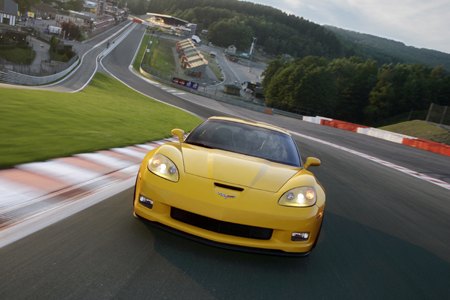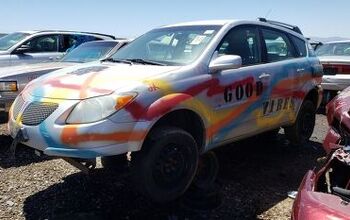General Motors Death Watch 61: Have a Heart
As GM fast approaches the day when it surrenders its world's largest automaker title to Toyota, it's important to remember that we're still talking about a corporate colossus. If you include fleet sales, The General makes one in every four vehicles sold in the United States. Obviously, GM's problem isn't volume. It's profitability. GM's US operations are still designed to cater to a third of the US car market. That's Hell of a lot of fat to trim– especially with a union that hears "efficiency" and thinks "downsizing". Meanwhile, The General has an even bigger problem: it doesn't have a heart.
An automotive brand's "heart" is the car that the average customer associates with a given brand. It's the vehicle whose character most clearly personifies the brand's values. Toyota has the Camry. Honda has Accord. Nissan has the Altima. Ford had the Taurus (and demolished it to push the Explorer). GM has nothing. More importantly, Chevy has nothing. Remember "the heartbeat of America"? It's on the crash-cart, waiting for a transplant.
Ironically, Chevrolet sells The General's halo car: the Corvette. The 'Vette is a world-class sports car whose style, power and handling has met with universal approval. It's a sexy, well-engineered vehicle that should instill pride into the heart of every American enthusiast. And yet the 'Vette is not Chevrolet's heart. How could it be? At $50k plus, it's far too expensive for the average car buyer's pocketbook. Even if were affordable, a two-seater does not speak to the average car buyer's real world aspirations. If it does, the Corvette says one thing: toy. Just like the Pontiac Solstice, the 'Vette is little more than showroom eye candy.
Meanwhile, at the other end of the financial spectrum, the $10k Aveo is an equally unlikely candidate for becoming Chevy's "people's champion." Even without considering its flaws, the Korean car's point of origin rules it out. The new Impala is a sensible, well-built car, but it's the automotive equivalent of a straight-to-video movie: a rental car wannabe from the word go. The Malibu is decently equipped, reasonably frisky, sensibly priced and no rental slut (unlike its predecessor). But it's another slab-sided scoop of low-calorie vanilla with a Motel Six interior: one of the few cars that can make an Accord or Camry look sexy. As for Chevy's trucks, that ship has sailed.
Chevrolet seems to think that selling something that doesn't suck is enough to fill this gap. It's not. Chevy needs one bullet-proof, brand-defining car. The company needs to build one superb machine that buyers can examine inside and out and instantly "get it". An inherently desirable car that tells the world what it means to be a Chevy. The heart car should have a modern engine (a baby Northstar), the best possible cabin materials, plenty of standard equipment (in recognizable trim levels), superb build quality and just enough style that you know who built it.
Profit margins have nothing to do with it. The only way Chevrolet can claw their way back to credibility is to take the financial hit and build something so outstanding in both form and function that it redefines GM's home brand for years to come. Profit can come later– and it will. Good niche vehicles grow off of good roots. (Weak trunks grow into Azteks.) While the heart car's volume grows, it will provide a decent base for more profitable spin-offs. A good heart car could spawn a sport coupe, and some of those vaunted "crossovers", including the original crossover, the minivan.
In fact, Chevy's flagship model could be a minivan. There are over a million of these family haulers sold in the US every year. (Chrysler, Honda and Toyoda own 75% of the market, with the Japanese skimming the cream, and Chrysler doing the volume.) GM's current minivans are warmed-over nose-jobs grafted onto overly-narrow European platforms– more proof that GM doesn't have a clue. A feelgood proletarian minivan with genuine American style and plenty of class could be a profitable volume seller, and an appropriate model to show the world what a "real" Chevy is all about– well, these days.
Why go on the attack now? Because the best defense is a good offense. When GM abandons a market, the competition consolidates and goes for it. Backing only the profitable lines built GM's bottom line– barely– but it kills brands. Even now, Toyota and Nissan are taking aim at the full-size pickup truck market. They've been at this for years; they haven't got it all together yet. But they're going to keep whacking the door with an axe until it opens. (We've seen this movie before.) In both pickups and mass market motors, GM hasn't pushed back. It can't. Not because it lacks guts or talent or money. It simply doesn't have the heart.
More by Andrew Dederer
Latest Car Reviews
Read moreLatest Product Reviews
Read moreRecent Comments
- AMcA My theory is that that when the Big 3 gave away the store to the UAW in the last contract, there was a side deal in which the UAW promised to go after the non-organized transplant plants. Even the UAW understands that if the wage differential gets too high it's gonna kill the golden goose.
- MKizzy Why else does range matter? Because in the EV advocate's dream scenario of a post-ICE future, the average multi-car household will find itself with more EVs in their garages and driveways than places to plug them in or the capacity to charge then all at once without significant electrical upgrades. Unless each vehicle has enough range to allow for multiple days without plugging in, fighting over charging access in multi-EV households will be right up there with finances for causes of domestic strife.
- 28-Cars-Later WSJ blurb in Think or Swim:Workers at Volkswagen's Tennessee factory voted to join the United Auto Workers, marking a historic win for the 89- year-old union that is seeking to expand where it has struggled before, with foreign-owned factories in the South.The vote is a breakthrough for the UAW, whose membership has shrunk by about three-quarters since the 1970s, to less than 400,000 workers last year.UAW leaders have hitched their growth ambitions to organizing nonunion auto factories, many of which are in southern states where the Detroit-based labor group has failed several times and antiunion sentiment abounds."People are ready for change," said Kelcey Smith, 48, who has worked in the VW plant's paint shop for about a year, after leaving his job at an Amazon.com warehouse in town. "We look forward to making history and bringing change throughout the entire South." ...Start the clock on a Chattanooga shutdown.
- 1995 SC Didn't Chrysler actually offer something with a rearward facing seat and a desk with a typewriter back in the 60s?
- The Oracle Happy Trails Tadge





































Comments
Join the conversation